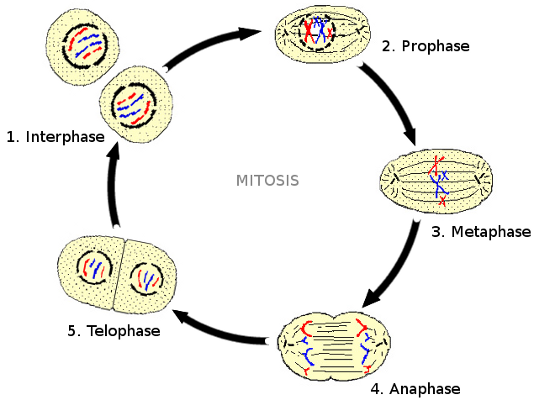What is cell mitosis?
Test your knowledge of cell mitosis by answering the following questions, and if you don't know the answers then read the text below to find out.
1. Mitosis is the process of ____ _________.
2. Mitosis involves _____ stages.
3. The first stage of mitosis is called the ___________ stage.
4. Two centrioles are created in the _____________ stage.
5. Chromosomes consist of two _____________.
6. The chromatids line up at the equator of the cell in the _____________ stage.
7. The pairs of chromatids begin to separate in the ____________ stage.
8 . The final stage of mitosis is called the __________ stage.
What is cell mitosis?
Mitosis is the process of cell division, during which one cell splits into two genetically identical daughter cells.
It involves the following five stages:

The stages of cell mitosis
1. Interphase - this stage includes all normal cell activity between periods of mitosis. It constitutes 90% of the life cycle of a cell; the other 10% covers all of the other stages. The cell also prepares for mitosis at this stage, growing in size as it synthesizes sufficient cytoplasm and nuclear protein for the daughter cells.
2. Prophase - two centrioles are created by the division of the centrosome, and these move to opposite poles of the cell, remaining connected by spindle-like fibers of centrosome. In the nucleus, the nucleolus disappears as the chromatin shortens and thickens, and divides into chromosomes (which consist of two chromatids joined by a centromere).
3. Metaphase - With the disappearance of the membrane of the nucleus, the chromatids align at the equator of the cell, attaching to the fibres of centrosome connecting the centrioles.
4. Anaphase - The two centrioles move further apart and the pairs of chromatids begin to separate toward opposite poles.
5. Telophase - The chromatids arrive at opposite poles of the cell, and new membranes form around the two sets of chromosomes, creating two nuclei. The spindle fibres also disperse, and the cell divides into two daughter cells identical to the original cell.
Reference : Human Physiology - Silverthorn (Amazon link)
Resources :
In this section we've added a few alternative study aids to help you along.
- Articles - Here you'll find a range of short articles on basic anatomy and physiology topics, complete with a few 'test yourself' questions for each one.
- Images and pdf's - Just in case you get tired of looking at the screen we've provided images and pdf files that you can print out and use for 'off-line' practice.
- Word Roots - When you learn the word roots, prefixes and suffixes contained within anatomical and medical terms, you can often work out what they mean. This can be a useful skill as you progress in your studies, so we've provided a dictionary to help you!
- Games - Finally in the resources section, we've added some simple games to make anatomy and physiology practice a little bit more fun.



